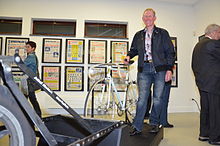Sportimonium

The Sportimonium is a museum in Hofstade, Belgium , a district of Zemst in Flemish Brabant . Because of the maintenance of traditional Flemish sports, the museum has been recognized by UNESCO as Best Practice Intangible Heritage .
history
The origins of the museum are based on a project by the Katholieke Universiteit Leuven , which has been researching the Flemish popular sport since 1973 under the direction of Professor Roland Renson . With few sources available, Renson sent his students “on site” to gather knowledge about traditional Flemish folk sports. During this field research, extensive information was gathered, for example about trabol , gaiibol , krulbol , kaatsen , struif , beugelen , klepschieten and other sports. The first collector's item was a worm-eaten cone from the village of schools . In 1980, the headquarters for Flemish popular sport (since 2006 the center for sports culture ) was founded in order to utilize the findings and manage the objects . In the following years, further research projects on Flemish sport were initiated and in 1985, in collaboration with other institutions besides the University of Leuven, merged into one organization.
A wooden beach house from 1938 in the Bloso Domein Hofstade , a 164 hectare nature reserve with sports facilities in Hofstade , was chosen as the location for the future museum . Sportimonium was chosen as the name for the new museum , as a trunk word from sport and patrimonium . The museum opened on May 7, 2004.
Terrain and Buildings
From 1921, the area in Hofstade around a quarry pond that was created during the construction of the Brussels - Mechelen - Antwerp railway line was used as a local recreation area. In 1932 a company took over the business and expanded the site; On July 21, 1933, Oud-België was officially opened by King Albert with a lake, beach, kiosks, restaurants, mini-train, pedal boats and other attractions . There was also a cycling track on which the Belgian track world champion Jef Scherens won the De Groote Prijs van Hofstade on the opening day . On some days up to 35,000 visitors came, most of them from Brussels. The area was nicknamed the poor mensen zee because many visitors came to Hofstade who could not afford a trip to the coast.
In 1936 the Ministry of Health took over the site and decided on a new concept, the old infrastructure was demolished. The architect Victor Bourgeois was commissioned with the overall planning . An outdoor swimming pool and a boathouse were built, and a larger beach was created with a beach house, terrace, changing rooms and sanitary facilities in a new, modern style. The opening took place in 1939.
The architect of the wooden beach house was Maxime Wijnants , like Bourgeois a member of the Congrès International d'Architecture Moderne (CIAM). The crescent-shaped building consists almost entirely of wood - the tropical woods Kambala and Limba - as well as large glass fronts. The narrow side of the house is parallel to the beach. The building, which has been a listed building since 2001, has been carefully renovated for museum purposes, and the former changing rooms, for example, have proven to be ideal exhibition spaces.
Exhibitions and activities
The permanent exhibition of the Sportimonium is housed in the beach house. The history of Belgian sport over 150 years is presented here, including exhibits by cyclists Eddy Merckx and Jef Scherens, soccer player Jean-Marie Pfaff and athlete Tia Hellebaut . Objects related to Olympic history are on display in the Olympic Passage , such as the first Olympic flag with five rings from 1920.
One cabinet is dedicated to the Belgian water polo player , fencer and sports journalist Victor Boin , who became the first athlete to take the Olympic oath at the 1920 Olympic Games in Antwerp .
In the Volkssporttuin , visitors can try their hand at traditional sports and test their own performance in the sports lab . The history of the movement over 40 centuries is presented in the Tijdlijn . In total, the museum has over 30,000 artifacts and documents.
The documentation center provides documents, books and magazines on the history of sport.
literature
- Openbaar Kunstbezit Vlaanderen (Hrsg.): Sportimonium. More than a museum about sports .
Web links
- Sportimonium website. In: sportimonium.be. March 6, 2015, accessed March 27, 2015 (Dutch).
- Ronald Renson / Erik De Vroede: Sportimonium: an Olympic museum in Belgium. In: DAGS magazine for the 5th DAGS Symposium, 2012. In: issuu.com. September 29, 2012, pp. 48–54 , accessed April 1, 2015 (English).
Individual evidence
- ↑ a b Sportimonium. In: olympic.org. Retrieved April 1, 2015 .
- ↑ Sportimonium , p. 4f.
- ↑ Sportimonium , p. 5.
- ↑ Sportimonium , p. 6.
- ↑ Geschiedenis van het Bloso-domein on sportimonium.be ( Memento of the original from April 11, 2015 in the Internet Archive ) Info: The archive link was automatically inserted and not yet checked. Please check the original and archive link according to the instructions and then remove this notice. (PDF file)
- ^ Werner E. De Bondt: Collection in the Dressing Room . In: Openbaar Kunstbezit Vlaanderen (Hrsg.): Sportimonium. More than a museum about sports . S. 34-38 .